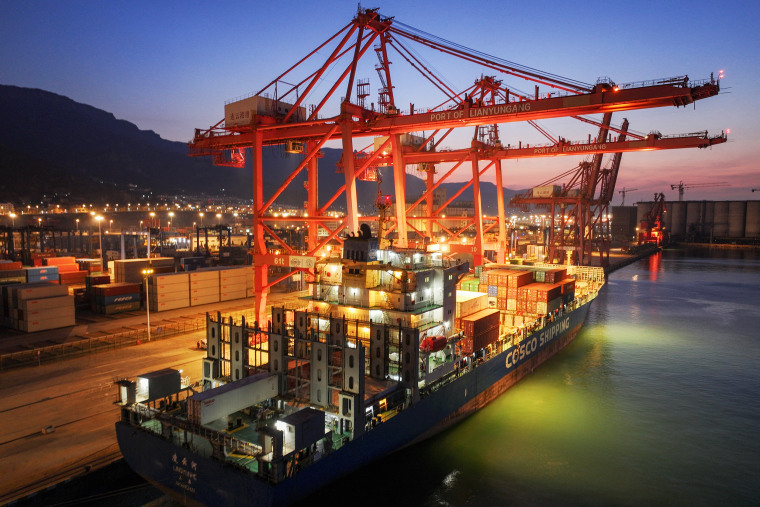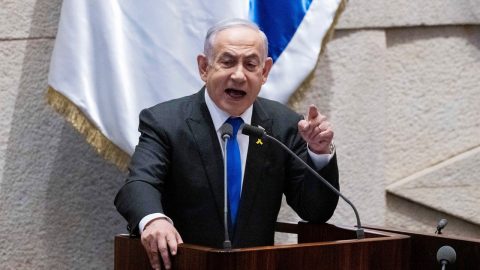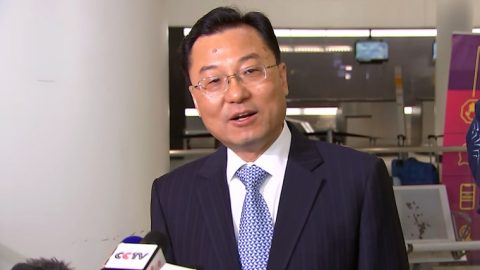HONG KONG — China retaliated immediately Tuesday as a 10% U.S. tariff on all Chinese goods went into effect, announcing a series of measures including its own levies of 10% to 15% on some U.S. products.
Starting Feb. 10, China will impose an additional tariff of 15% on coal and liquefied natural gas and a 10% tariff on crude oil, agricultural machinery, large-displacement automobiles and pickup trucks, the government said.
The Chinese announcement came minutes after the U.S. tariff took effect at 12:01 a.m. ET, the only one to go ahead after President Donald Trump paused 25% tariffs he had announced on goods from Canada and Mexico.
The failure to forestall tit-for-tat tariffs with China raises the risk of a spiraling trade war between the world’s two biggest economies.
“This unilateral tariff hike by the U.S. side seriously violates World Trade Organization rules, does nothing to solve its own problems, and undermines normal China–U.S. economic and trade cooperation,” the Customs Tariff Commission of the State Council, China’s Cabinet, said in a statement.

In addition, Beijing announced an investigation into Google for alleged anti-trust violations, and export controls on items related to tungsten and other rare earth elements that are critical components of high-tech products.
It also said U.S. gene sequencing company Illumina and PVH Corp., the owner of Calvin Klein and Tommy Hilfiger, would be added to the “unreliable entity list,” restricting their ability to operate in China.
Mainland Chinese markets remain closed for the Lunar New Year holiday. Other Asia-Pacific markets were mostly still up on news that the Canadian and Mexican tariffs had been put on hold, CNBC reported, though stocks in the Chinese territory of Hong Kong pared gains.
Beijing said it had referred the U.S. tariff measures to the World Trade Organization “to safeguard its legitimate rights and interests.”
The additional U.S. tariff “seriously violates WTO rules and is an egregious act, representing typical unilateralism and trade protectionism,” a spokesperson for the Chinese Ministry of Commerce said.
The U.S. has blocked the appointments of appellate judges to the World Trade Organization since Trump’s first term, leaving it largely unable to mediate international trade disputes. But China could still use a lawsuit to gather international support against the U.S. tariffs.
“The U.S. approach severely undermines the rules-based multilateral trading system, damages the foundation of Sino-U.S. economic and trade cooperation, and disrupts the stability of global industrial and supply chains,” the Chinese Commerce Ministry said.
Many Chinese products are already subject to tariffs that were introduced by Trump in his first term and were maintained or in some cases expanded by then-President Joe Biden.
Beijing’s newly announced tariffs are more targeted than the U.S. tariff, which appears to apply to all Chinese products, and some may have more impact than others. China doesn’t import much crude oil from the U.S., for example, while Google is blocked in China and has limited business in the country after withdrawing in 2010 over a censorship dispute.
Others could present more of a challenge. The U.S. imports about a quarter of its tungsten from China, which produces about 80% of the world’s supply, meaning there are few alternative sources. The critical metal is used by chipmakers such as Nvidia.
China’s tariffs are “largely symbolic” and will have limited impact on the U.S., said Tianchen Xu, senior economist at the Economist Intelligence Unit in Beijing, adding that they cover only 8.5% of all Chinese imports from the U.S. last year.
They also represent a change in approach from Trump’s first term, when China responded to tariffs more strongly. That is more difficult now as China struggles with an economic slowdown.
“Trump wants a lot from the Chinese side, and he will launch one attack after another,” Xu said in an email. “China has no intent to escalate the conflict, given that any escalation will exert further pressure onto its economy.”
Trump announced the 10% China tariff Saturday along with 25% tariffs on goods imported from Canada and Mexico, citing border security, as well as the illicit international flow of drugs such as fentanyl. Though the Canadian and Mexican tariffs have been paused for 30 days after talks with those countries’ leaders, no such deal appears to have been struck with China.
Trump is expected to speak with Chinese leader Xi Jinping “in the next couple of days,” White House press secretary Karoline Leavitt said Monday.
China appears to be taking a different approach than Canada, Mexico and Colombia, all of which made concessions to the U.S. to avoid the immediate imposition of tariffs.
“I would’ve waited to try to negotiate with Trump, because Trump might have avoided the tariffs for good if China had shown some compromise,” said Alicia Garcia-Herrero, chief economist for Asia Pacific at Natixis in Hong Kong.
Trump said the 10% tariff on China was meant to pressure Beijing to stem the flow of precursor chemicals from China to Mexico and other countries, where they are processed into fentanyl and then smuggled into the U.S.
Though the U.S. and China say Beijing has taken some action, China says that the best way for the U.S. to solve its deadly fentanyl crisis is to reduce domestic demand and that tariffs could affect future cooperation on drug control.
“Fentanyl is an issue for the U.S.,” the Chinese Embassy in Washington said in a statement Tuesday. “In the spirit of humanity and goodwill, China has given support to the U.S.’s response to this issue.”
Trump said Monday that the 10% tariff was just “an opening salvo.”
“If we can’t make a deal with China, then the tariffs will be very, very substantial,” he said.








Recent Comments